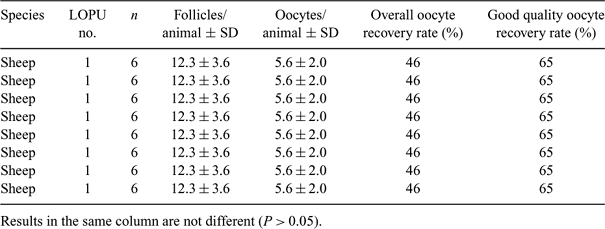274 LAPAROSCOPIC OVUM PICK-UP IN SHEEP AND GOATS: EFFECTS OF REPEATED RECOVERIES AND FOLLICULAR DIAMETER
A. Gibbons A , F. Pereyra Bonnet A , M. Cueto A , M. Catala B and D. Salamone BA Instituto Nacional de Tecnología Agropecuaria, Estación Experimental Bariloche, CC 277 (8400) Bariloche, Argentina
B Laboratorio Biotecnología de la Reproducción, Facultad de Agronomía, Universidad de Buenos Aires, Buenos Aires, Argentina
Reproduction, Fertility and Development 18(2) 244-245 https://doi.org/10.1071/RDv18n2Ab274
Published: 14 December 2005
Abstract
Laparoscopic ovum pickup (LOPU) is a modern technique that may be used in programs of sheep and goat in vitro embryo production. The effects of repeated recoveries and follicular diameter on the efficiency of LOPU were evaluated in these species. In six Merino donor sheep and five Criolla goats, ovarian stimulation for follicular development was performed by administering a single dose of 60 mg NIH-FSH-P1 (Folltropin®; Bioniche, Canada) and 300 UI of eCG (Novoromon 5000®; Syntex, Argentina). Every four days, a total of 4 LOPU in sheep and 3 in goats were performed 24 h after each ovarian stimulation treatment. The intravaginal sponge with 60 mg of medroxyprogesterone (Esponjas Vaginales Syntex®; Syntex, Argentina) were removed after the last LOPU. Follicular fluid was aspirated under laparoscopic observation according to the follicle diameter with a cannula for intrauterine artificial insemination without a vacuum pump. The number and size of follicles, oocyte quantity and quality and recovery rate were evaluated. A total of 566 follicles were aspirated (14.4 ± 2.4 follicles/sheep and 14.6 ± 7.5 follicles/goat), yielding a total of 263 oocytes (6.8 ± 1.5 oocytes/sheep and 6.6 ± 2.9 oocytes/goat) and a recovery rate of 47% in sheep and 46% in goats (Table 1). In both species, there were no significant differences in the number of aspirated follicles, recovered oocytes, overall recovery rate, and the recovery rate of good quality oocytes in the repeated LOPU. The oocyte recovery rates in sheep differed significantly according to the follicular size (55% in large follicles, 36% in small follicles; P < 0.05), whereas in goats recovery rates of oocytes related to follicular size showed no significant differences (42 and 54% for large and small follicles, respectively). Follicular sizes from which oocytes were obtained was not a determining factor in the recovery rate of good quality oocytes. The technique used would allow effective and repeated oocyte recoveries for in vitro embryo production in sheep and goats.

|


